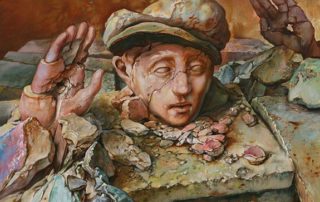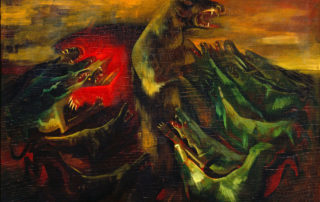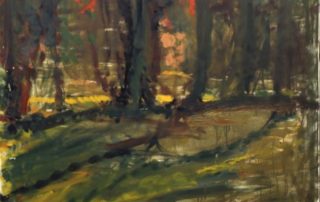Rachel Stern2022-12-07T18:53:36-05:00May 25th, 2022|Events, Lectures, Past Events|
Image above: Samuel Bak, Warsaw Excavation, 2007. Oil on canvas, 16 x 20 in. Image Courtesy Pucker Gallery © Samuel Bak Samuel Bak was 6 years old when the Nazis began ending his childhood, as the war that they engendered would soon extend to his native Vilnius. The number “6” became an important element in his art, since it is also the number of the Commandment with which God enjoins us not to commit murder, for which the Holocaust represented such a profound abrogation. His father smuggled him out of the ghetto in the sack that he was still permitted to use to gather firewood—and was subsequently murdered by the regime. By then Bak himself had already [...]
Rachel Stern2022-05-19T05:21:58-04:00April 25th, 2022|Events, Lectures, Past Events|
Between 1933 and 1945, the National Socialist regime controlled artistic work in Germany. Particularly artists who were persecuted based on their religion, race, or political views fled into exile due to threats from the government. But what happened to the artists who remained in the country? Isolation, lack of an audience, and limited exchange impacted the creativity of the individuals who were deprived of a basis for work and life under National Socialism. Their situation is often described in a generalized way as “ostracism” or “inner emigration.” In light of the multilayered and divergent personal circumstances, however, these terms fall short of the mark. Image above: Hans Grundig, Clash of the Bears and Wolves, 1938, Oil on plywood, 90,5 [...]
Rachel Stern2022-08-26T05:10:27-04:00October 6th, 2021|Events, Lectures, Past Events|
Fritz Ascher (Berlin 1893 - 1970 Berlin) almost made it out of Germany as the persecution of the Jews was developing. SINCE HE HAD been arrested and released from concentration camp and prison after several months, friends managed to book passage on a ship to Shanghai, but the German Nazi bureaucracy refused to let him leave the country. Ascher found refuge in the basement of his deceased mother's friend, Martha Grassmann--in a house located in the Grunewald, the heart of the Nazi brass residential neighborhood in Berlin. In hiding--an interior migration--he shifted from vibrantly expressionist paintings and drawings to dense poetry. AFTER the war he emerged to a Germany very different from the one he had known before and [...]
Rachel Stern2022-02-18T05:46:15-05:00April 29th, 2021|Lectures, Past Events|
Lecture by Dr. Martina Weinland Commissioner for Cultural Heritage at the Museum of the City of Berlin in Berlin (Germany) Followed by Q&A moderated by Rachel Stern Director and CEO, Fritz Ascher Society in New York The Berlin artist Jeanne Mammen (1890-1976) is best known for her depictions of strong, sensual women and Berlin city life. But there is much more to her 70 years of artistic output, with unique sketches, paintings and sculptures. In 1975, she tells the art historian Hans Kinkel, who conducts the only interview she will ever give: “You must always write that my pictures were created between 1890 and 1975. …I have always wanted to be just a pair of eyes, walking through [...]






